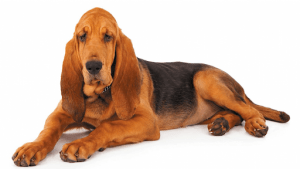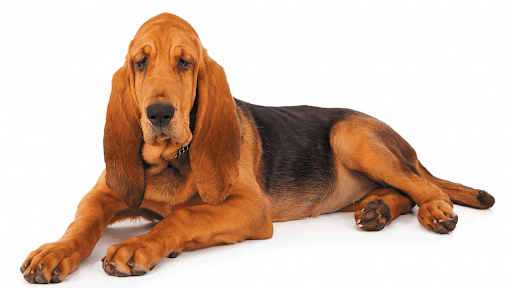Grooming a Bloodhound at home is pretty simple. Its short coat is easy to brush, and the only other work needed is regular nail trimming, ear cleaning, and mouth care. Bathing is necessary only when the dog is dirty. Don’t think that a bath will help reduce that houndy odor. The odor is built in, and a bath won’t make it go away.
Start accustoming your puppy to being groomed as soon as you take it home. Even a squirmy Bloodhound can learn to sit still for a few minutes while being brushed and having its eyes and ears cleaned. This will make it easier for you and other people to handle the dog, something that’s especially important for trips to the veterinarian’s office or being judged at shows.
Save your back. Grooming will be easiest if your dog is up on a grooming table, picnic bench, or other flat, sturdy surface. Since your Bloodhound will grow quickly, one of the first things it should learn is how to jump up on the table. Encourage your dog to jump up by patting the table and saying “Table”. Praise it or give a treat when it complies.
Brushing the Coat
Regular brushing is the foundation of the grooming process. Using a rubber hound glove, which can be purchased at a pet supply store, or online, brush your Bloodhound weekly or even daily. Brushing removes loose hair and dead skin cells, distributes skin oils, and helps keep the coat shiny. It feels good, too, and your dog will soon come to enjoy being brushed.
Avoid brushes with long or sharp bristles, such as pin brushes or wire slicker brushes. During the shedding season, a terrier stripping blade can come in handy to remove loose coat.
Vacuuming the Coat
Another good way to keep a Bloodhound’s coat clean is with a vacuum hose. Yes, some Bloodhounds enjoy being vacuumed. Vacuuming pulls out loose hair, dirt and dust in the coat, and fleas and flea eggs. Combined with brushing, vacuuming can keep your Bloodhound very clean.
To accustom your puppy to the sound of the vacuum, let it hear and see it first. Bring the hose up to the pup slowly so you don’t frighten it, and gently move it over the dog’s entire body. Like brushing, vacuuming feels good, so your dog should enjoy it if introduced properly.
Bathing the Coat
 It’s rare that a Bloodhound needs a bath. Only if your dog is exceptionally dirty or is competing in a show should it need one. That’s good, because by the time you and the dog are finished with the bath, you may need to redecorate the bathroom!
It’s rare that a Bloodhound needs a bath. Only if your dog is exceptionally dirty or is competing in a show should it need one. That’s good, because by the time you and the dog are finished with the bath, you may need to redecorate the bathroom!
There will be lots of shaking of wet dog going on, so wear old clothes that you don’t mind getting wet, and pull together your supplies before you bring the dog in. You’ll need plenty of towels, cotton balls to place in the ears to keep the water out, and a shampoo made for dogs.
Put a drop of mineral oil in each eye to help keep water out. Wet the dog thoroughly with warm water, and lather, starting at the head and working your way to the tail. Rinse well, being sure to get all the shampoo out from under the folds of skin. Leftover soap on the skin can be irritating.
A vinegar rinse (one part cider vinegar to one part water) can help ensure that you get all the soap out of the coat.Blot up as much water from the coat as possible and towel-dry the dog thoroughly.
Don’t let the dog outside or in any cold or drafty areas until it’s completely dry. (This is a good time for the dog to be in its crate.) Put a sweatshirt on the dog or wrap a blanket around it to keep it warm while it dries. Consider using a forced-air dryer to get the dog completely dry in a timely manner.
Coat and Skin Problems
Itching, coat loss, and hot spots can have a number of causes, from external parasites such as fleas and mites to allergies to deficiencies caused by poor nutrition. It’s pretty easy to determine whether a Bloodhound has fleas, but other skin problems will probably require a little detective work to identify and treat.
For instance, a food allergy requires switching the dog to a food containing ingredients the dog has never eaten before. For a trial period of six to eight weeks, the dog must eat only this food – no treats, rawhides, or table scraps. At the end of the trial period, you can see whether the dog’s skin condition has improved.
If it has, the next step is to add ingredients back into the dog’s diet, one at atime, to figure out what’s causing the allergic response. Once that is determined, the dog can be placed on a diet that doesn’t contain the offending ingredient.
Non-food allergies can be caused by pollen, cats, certain grasses or molds, or such things as chemicals in carpets. Allergy tests are available from veterinary dermatologists, who can then put your dog on a desensitization program. Allergy shots may be necessary to keep the condition under control. Fortunately, allergies are not especially common in Bloodhounds.
If a nutritional deficiency is suspected, your veterinarian will probably recommend switching the dog to a higher quality food that is complete and balanced for the dog’s life stage. For instance, a young being fed a food for adult dogs may not be getting enough protein and fat in its diet. Dogs that eat primarily table scraps can also lack proper nutrition.
Other conditions that can affect your dog’s skin are ringworm, seborrhea, and thyroid deficiency. Your veterinarian can diagnose these problems and suggest an appropriate course of treatment.
Dental Care
To keep its mouth healthy, clean out your Bloodhound’s flews after every meal, and brush its teeth. Brushing prevents the formation of plaque and tartar, and keeps bacteria from multiplying and causing infection. For best results, brushing should be done daily, but even a weekly brushing is better than nothing.
Use a soft toothbrush and a toothpaste made for dogs (toothpaste made for humans can cause stomach upset in dogs). You can also make your own toothpaste by making a paste of baking soda, a little salt, and water.
To help keep tartar scraped off between brushings, feed hard biscuits or dry food, and make sure your dog has access to dentally benificial tous such as rope bones or rawhides.
Eyes and Ears
Keep the corners of the eyes free of dried mucus, and the ears dry and clean. One way to do this is to wipe the ears out with witch hazel every week. Keep an eye out for ear mites or signs of ear infection, such as redness, tenderness, or the dog shaking its head frequently or pawing at its ears.
Anal Sacs
At the other end of your Bloodhound are its anal sacs, the contents of which serve to lubricate and mark your dog’s feces as they are eliminated. The anal sacs are internal, but you can feel them externally on each side of the anus.
Anal sacs sometimes become impacted, causing the dog to lick at its rear or scoot it across the floor or ground in an attempt to release the contents. Check the anal sacs regularly to make sure they aren’t impacted. Your veterinarian can show you how to empty the anal sacs if necessary.
Nail Care
Most important, keep the nails well trimmed. Bloodhounds are sensitive about their feet, and yours will probably act as if you are killing it when you trim the nails, but don’t let it fool you. When done properly and often, nail trimming doesn’t hurt and is an important part of keeping the dog’s feet healthy.
Use a large nail trimmer made for dogs and clip just at the curve of the nail. If the nails are light-colored or clear, you can see the dark line of the quick. Avoid nicking it, because that is painful and can cause the nail to bleed.
Keep some Quik-Stop or cornstarch handy to stop the bleeding if you make a mistake. The breeder or your veterinarian can show you where to trim to avoid any problems.

